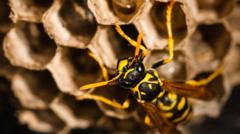A radioactive wasp nest containing radiation levels registered at ten times the permissible amount was uncovered at the Savannah River Site (SRS) in South Carolina, according to a report released by the US Department of Energy. Workers conducting routine inspections discovered the nest on July 3, situated near massive storage tanks containing liquid nuclear waste. The nest was promptly sprayed to eliminate the wasps, and subsequently bagged as radiological waste, with no live wasps found at the location.
The investigation revealed that the detected contamination stems from "onsite legacy radioactive contamination," indicating residual radioactivity from past Cold War-era operations when the site was actively engaged in producing nuclear weapon components. Though this facility remains operational, its current focus is on providing nuclear materials for power generation rather than for weaponry. The Department of Energy's findings assert that the wasps inhabiting the nest likely possessed significantly lower radiation levels compared to the nest itself and that their limited flying range indicates a minimal risk of contamination dispersal beyond the facility’s extensive 310-square-mile area. The report reassured that no contamination was found in surrounding areas and confirmed there had been no impact on employees, the environment, or public health.
Despite these assurances, the Savannah River Site Watch, a local watchdog organization, has raised concerns regarding the lack of clarity about the origins of the radioactive waste found in the nest. Spokesman Tom Clements expressed frustration over what he termed an inadequate explanation from SRS officials and emphasized apprehensions about potential leaks from the active waste tanks, a liability given the site is known for generating vast quantities of liquid nuclear waste—over 165 million gallons historically, with 43 underground tanks still in operation.
As scrutiny increases over the SRS, the urgency for greater transparency and accountability surrounding radioactive contamination issues becomes ever more pressing.





















